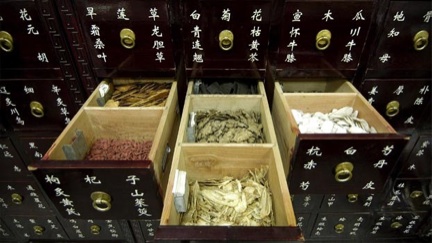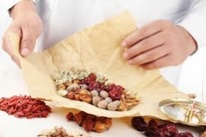
Chinese Herbal Therapy


China has the longest herbology practice history in the world. Since the first seminal medical text (Huangdi Neijing Suwen 2698-2596 B.C) established the foundation of Chinese herbal medicine, nearly 5,000 years of development has made herbology become the most important modalities utilized in Traditional Chinese Medicine (TCM). The practitioner designs an herbal remedy using one or two predominating ingredients that target the illness, and then adds several other ingredients to cover the related symptoms. The consolidated herbal medicine prescription is a cocktail of many herbs tailored to the individual patient. One batch of herbs is typically decocted twice over the course. A course is usually once a day for a single day, three days, or longer depends on whether the illness is acute or chronic. The principle of the herbal treatment is to design a formula to adjust the patient''s yin/yang conditions, get to the root, and treat the cause. Sometimes, ingredients are needed to cancel out toxicity or side-effects of the main ingredients. Sometimes, the main ingredients are needed to be reinforced with other ingredients. Some herbs require the use of other herbs as catalyst or otherwise the brew is ineffective. The latter steps require great experience and knowledge, and make the difference between a good Chinese herbal doctor and an amateur. Unlike western medications, the balance and interaction of all the ingredients are considered more important than the effect of individual ingredients. One formula treats different illnesses; Different formulae treat the same illness. The key to success in TCM herbology is to design safe and effective formulae to treat the cause instead of symptoms, treat patients as each individual rather than repetitive general.
Chinese herbology often incorporates ingredients from all parts of plants, the barks, seeds, leaves, stems, flowers, roots, and also ingredients from animals and minerals. In respect to the Mother Nature and save the endangered species, Traditional Chinese Medicine has discontinued the use of any parts from endangered animals, therefore modified the herbal formulae and introduced hundreds of new herbals in accommodate the current healthcare demand. A study has confirmed that without using animal parts Chinese herbal medicine does have the same expected efficacy.
1. Chinese herbs have been used for centuries. The first herbalist in Chinese tradition is Shennong, a mythical personage, who is said to have tasted and ingested hundreds of herbs and imparted his knowledge of medicinal and poisonous plants to the agricultural people. The first Chinese manual on pharmacology (Shennong Emperor's Classic of Materia Medica), lists some 365 medicines of which 252 of them are herbs.
2. Yellow Emperors Inner Classic (Huang Di Nei Jing) was a dialogue between the Yellow Emperor(2698-2596 B.C.) and his physician Qi Bo, in which they discuss the whole spectrum of Chinese Medicine including topics such as herbs, acupuncture, yin-yang, five-elements, pathology, diagnosis, and etiology of disease. The work was compiled around 305-204 B.C. The Inner Classic is the foundation for theory and philosophy of Traditional Chinese Medicine.
3. The historical tradition continued with the work of a famous physician who lived around the third Century A.D. named Zhang Zhong Jing. He was one of the most celebrated Chinese physicians who compiled two classics- (Shang Han Lun-Discussion of Cold Induced disease) and (Jin Gui Yao Lun-Synopsis of Prescriptions of the Golden Chamber). These works are still referenced today for the diagnosis, differentiation of yin-yang and 6 stages and treatments.
4. Around 452 A.D. a Taoist named Tao Hong Jing contributed to Chinese Herbal Medicine by editing the original Classics of Materia Medica according to kingdom - plants, animal, etc. He also increased the total entries to 730 medicinal substances.
5. In 1618 A.D. during the Tang Dynasty the government contributed by compiling the first official Materia Medica named Xin Xiu Ben Cao. This great work includes 844 illustrated pages.
6. During the Sung Dynasty (960-1279 A.D.), a physician named Tang Shen Wei increased the Materia Medica to 1746 substances.
7. Ming dynasty the most comprehensive medical book named Compendium of Materia Medica-(Ben Cao Gang Mu) was compiled by Li Shi Zhen. With over 52 volumes, and 30 years over research, it includes 1892 substances with over 100 illustrations and 10,000 prescriptions
8. Today the Materia Medica is being further developed and refined by clinical and scientific data. Most of the research is being done in China. Each herb is listed with the flavors, properties, meridian entered, functions, clinical use, match and combinations, dosage, process precautions. The data also includes pharmacological research such as antimicrobial effect, antiviral effect, antifungal effect, effect on blood pressure, effect on smooth muscle, endocrine effect, central nervous system effect, use in gynecology, etc.
9. In 1950, China officially unified Traditional Chinese Medicine with Western Medicine; Chinese herbology has become healthcare practices in hospitals. In the late 1950's to the 1960's herbal medicine researchers continued further study the ancient texts, clinical efficacy of various diseases, structural education systems and practice standard were established.
10. In the 1970's, Traditional Chinese Medicine and Western Medicine have become dual medical system in China. China has taken the lead in researching all aspects of herbology application and clinical effects. Herbology has developed specialties on pediatric, gynecology, geriatric, orthopedics, cadiology, respirology, ear/nose/throat, gastrology, oncology, traumatology, cosmetology, dermatology, andrology, nephropathy, urology, psychology, rehabilitation, sports medicine, and so on.
11. In the last three decades, Chinese herbology has become an increasingly popular alternative therapy benefiting billions of people. It has been recognized, practiced and taught throughout the world. WFCMS (World Federation of Chinese Medicine Societies) has been founded. Currently WFCMS has 157 Chinese medicine societies in 50 countries and regions.
Chinese physicians use the following categories to classify traditional Chinese herbs:
- The Four Natures
- The Five Tastes
- The Entered Meridians
The earlier (Han through Tang eras) Ben Cao (Materia Medicae) began with a three-level categorization:
Low level -- drastic acting, toxic substances Middle level -- medicinal physiological effects High level -- health and spirit enhancement
During the neo-Confucian Song-Jin-Yuan era (10th to 12th Centuries), the theoretical framework from acupuncture theory (which was rooted in Confucian Han theory) was formally applied to herbal categorization (which was earlier more the domain of Daoist natural science). In particular, alignment with the Five Phases (Tastes) and the 12 channels (Meridians theory) came to be used after this period.
The Four Natures
This pertains to the degree of yin and yang, ranging from cold (extreme yin), cool, neutral to warm and hot (extreme yang). The patient's internal balance of yin and yang is taken into account when the herbs are selected. For example, medicinal herbs of "hot", yang nature are used when the person is suffering from internal cold that requires to be purged, or when the patient has a general cold constituency. Sometimes an ingredient is added to offset the extreme effect of one herb.
The Five Tastes
The five tastes are pungent, sweet, sour, bitter and salty, each of which their functions and characteristics. For example, pungent herbs are used to generate sweat and to direct and vitalize qi and the blood. Sweet-tasting herbs often tonify or harmonize bodily systems. Some sweet-tasting herbs also exhibit a bland taste, which helps drain dampness through diuresis. Sour taste most often is astringent or consolidates, while bitter taste dispels heat, purges the bowels and gets rid of dampness by drying them out. Salty tastes soften hard masses as well as purge and open the bowels.
RESPIRATORY DISEASE
- Tonsillitis
- Acute Bronchitis
- Chronic Bronchitis
- Bronchial Asthma
- Pneumonia
- Pulmonary Abscess
- Pulmonary Emphysema
- Bronchiectasis
- Pulmonary Tuberculosis
- Pleurisy
CIRCULATORY DISEASE
- Hypertensive Disease
- Coronary Heart Disease
- Rheumatic Heart Disease
- Pulmonary Heart Disease
- Viral Myocarditis
- Arrhythmia
- Cardiac Insufficiency
DIGESTIVE DISEASE
- Acute Gastroenteritis
- Chronic Gastritis
- Chronic Enteritis
- Viral Hepatitis with Jaundice
- Viral Hepatitis without Jaundice
- Cirrhosis of Liver
- Hepatic Coma
- Portal Hypertension
- Cholelithiasis
- Biliary Ascariasis
- Pancreatitis
- Appendicitis
- Intestinal Obstruction
URINARY DISEASE
- Pyelonephritis
- Urinary Calculus
- Acute Glomerulonephritis
- Chronic Glomerulonephritis
- Renal Failure
- Acute Prostatis
- Chronic Prostatis
HEMOPOIETIC DISEASE
- Anemia
- Aplastic Anemia
- Allergic Purpura
- Idiopathic Thrombocytopenic Purpura (ITP)
- Leukopenia
- Leukemia
ENDOCRINE SYSTEM
NERVOUS SYSTEM DISEASE
MENTAL DISORDERS
METABOLIC DISEASE
JOINT DISEASE
